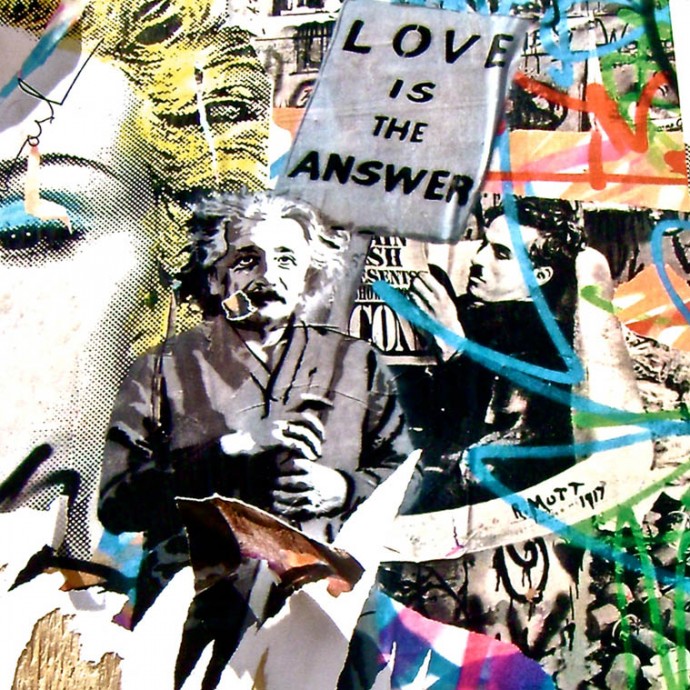An increasing number of street artists are creating works that seem to be purely decorative and superficial. They may be well-executed and eye-catching, but do really they have anything to say? Alexia Elliott explains why she believes streetart is in danger of selling out.
I find the state of the streetart scene today to be slightly disturbing in its superficiality. Isn’t streetart supposed to speak to the world? Or is it just a way to make the world look more interesting? I think that the answer is ‘both’ and yet, the likelihood of finding streetart pieces that actually have anything to say is getting scarcer day-by-day. The majority of streetartists seem to be removing the message from the medium and dumbing it down. They are transforming the style into just another kind of décor for members of the Millenial generation to buy at art markets.
The relevance of streetart lies not in its aesthetic but in its ability to speak to passers-by via that aesthetic… and by ‘passers-by’, I mean regular people, not just art critics. The most famous streetart pieces don’t just look good, they also say something that ‘everybody knows’ but that nobody has ever seen expressed that way in public, before.
Because of this, the medium is almost as crucial as the message. Scrawling one’s views outdoors, on the outside, underside or backside of an existing structure, is a big part of the statement. It says, “I may not own any property but my view still counts”.
But what happens when the artist doesn’t even have a view?
Commandeering a public space to put forth a marginal viewpoint is still a highly original move in a world in which the richest 1% (all of whom seem to have corporate interests) control most of the media, and an increasing proportion of the government. Commandeering a public space just to show off one’s clever design skills, meanwhile, is just a bit… WTF? I don’t want to denigrate the skills of ‘designer’ streetart teams that try to beautify derelict buildings worldwide, but if all an artist wants to do is showcase their funky new design concept, then mainstream culture already has plenty of ways for them to do that. What it lacks is plenty of ways in which the masses can express opinions and dissent.
Besides, aren’t we already exposed to too many fresh, clever designs each
day? New designs of notebooks, smartphones, clothes, cars, furniture? A clever new design is the Holy Grail of manufacturers that are desperate for us to keep buying but have nothing left to sell us, except the fact that our current design looks ‘outdated’. Design for design’s sake is entirely the preserve of Western commercial decadence. It greases the wheels of capitalism and keeps products rolling smoothly into our lives. Is that the point of streetart? Or is it more about flipping the capitalist car over and setting it alight?
Streetartists who hope to make their success through their badass style alone should be aware that doing so doesn’t come without its drawbacks.
Take Picasso for example. In 1915, he was among artists from the Cubist movement that were stationed in the same military unit during WWI. These artists ended up helping to develop camouflage patterns that enabled soldiers to kill the ‘enemy’ more efficiently. Is Picasso famous for helping to create camouflage today? Nope. In fact, he is famous for painting pieces like Guernica which criticized war, depicting it in a series of nightmarish, hallucinatory blobs. If you squint at this painting from far away, you can almost see the fading undertones of a camouflage pattern in it.
The above anecdote illustrates how any design – no matter how trippy or badass it looks – eventually ends up being linked to the product it’s found on, and not to the designer who created it. It also goes to show how the product the design is found on can brutally contradict the designer’s own values. This is the very reason why so many streetartists choose to make their values an integral part of their style; it’s also why they work outside of the confines of elitist spaces, controlled by wealth. In short, it’s why they become streetartists instead of gallery-artists or corporate artists.
In my view, artists who merely beautify the establishment’s walls with statement-free art are tacitly glamourizing the establishment by saying nothing against it. They are painting over the flaws of the status quo when they should be exposing them; they are beautifying it with fresh, new designs when they should be challenging it with a fresh, new perspective. Streetart that is purely decorative is a visual agreement; it’s a form of surrender. It is giving away talent for free, without any demands, to the same people who’d charge us to breathe the air around us, if they thought they could get away with it.
There are still street artists that make actual statements with their art, but they are in danger of being crowded out by this new breed of ‘designer’ streetartists. True streetartists, those who have something radical to say, are outside the system by nature and not by design; they need the space more because they have nowhere else to express themselves. In the face of erosion by the elements and the authorities, the only weapon that they can wield to defend that self-expression is a spraycan.







